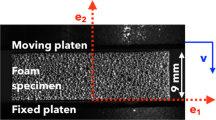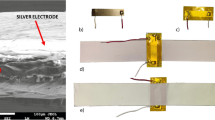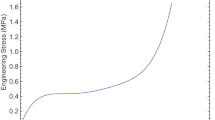Abstract
American football has both the highest rate of concussion incidences as well as the highest number of concussions of all contact sports due to both the number of athletes and nature of the sport. Recent research has linked concussions with long term health complications such as chronic traumatic encephalopathy and early onset Alzheimer’s. Understanding the mechanical characteristics of concussive impacts is critical to help protect athletes from these debilitating diseases and is now possible using helmet-based sensor systems. To date, real time on-field measurement of head impacts has been almost exclusively measured by devices that rely on accelerometers or gyroscopes attached to the player’s helmet, or embedded in a mouth guard. These systems monitor motion of the head or helmet, but do not directly measure impact energy. This paper evaluates the accuracy of a novel, multifunctional foam-based sensor that replaces a portion of the helmet foam to measure impact. All modified helmets were tested using a National Operating Committee Standards for Athletic Equipment-style drop tower with a total of 24 drop tests (4 locations with 6 impact energies). The impacts were evaluated using a headform, instrumented with a tri-axial accelerometer, mounted to a Hybrid III neck assembly. The resultant accelerations were evaluated for both the peak acceleration and the severity indices. These data were then compared to the voltage response from multiple Nano Composite Foam sensors located throughout the helmet. The foam sensor system proved to be accurate in measuring both the HIC and Gadd severity index, as well as peak acceleration while also providing additional details that were previously difficult to obtain, such as impact energy.






Similar content being viewed by others
References
Allison, M. A., et al. Validation of a helmet-based system to measure head impact biomechanics in ice hockey. Med. Sci. Sports Exerc. 46(1):115–123, 2014.
Buzzini, S. R. R., and K. M. Guskiewicz. Sport-related concussion in the young athlete. Curr. Opin. Pediatr. 18(4):376–382, 2006.
Camarillo, D. B., et al. An instrumented mouthguard for measuring linear and angular head impact kinematics in American football. Ann. Biomed. Eng. 41(9):1939–1949, 2013.
Campbell, K. R., et al. Laboratory evaluation of the gForce Tracker™, a head impact kinematic measuring device for use in football helmets. Ann. Biomed. Eng. 44(4):1246–1256, 2016.
Conidi, F. X. Helmets, sensors, and more: a review. Pract. Neurol. 15(2):32–36, 2015.
Crisco, J. J., et al. Frequency and location of head impact exposures in individual collegiate football players. J. Athl. Train. 45(6):549–559, 2010.
Crisco, J. J., et al. Head impact exposure in collegiate football players. J. Biomech. 44(15):2673–2678, 2011.
Daniel, R. W., S. Rowson, and S. M. Duma. Head impact exposure in youth football. Ann. Biomed. Eng. 40:976–981, 2012.
Duma, S. M., et al. Analysis of real-time head accelerations in collegiate football players. Clin. J. Sport Med. 15:3–8, 2005.
Duma, S. M., et al. Analysis of real-time head accelerations in collegiate football players. Clin. J. Sport Med. 15(1):3–8, 2005.
Fainaru-Wada, M., and S. Fainaru. League of Denial: The NFL, Concussions, and the Battle for Truth. New York: Three Rivers Press, 2013.
Foster, J. K., J. O. Kortge, and M. J. Wolanin. Hybrid III-A Biomechanically-Based Crash Test Dummy. SAE International, 1977.
Funk, J. R., et al. Biomechanical Risk Estimates for Mild Traumatic Brain Injury. Annual proceedings/Association for the Advancement of Automotive Medicine. Association for the Advancement of Automotive Medicine, vol. 51, pp. 343–361, 2007.
Funk, J. R., et al. Validation of concussion risk curves for collegiate football players derived from HITS data. Ann. Biomed. Eng. 40(1):79–89, 2012.
Gadd, C. W. Use of a Weighted-Impulse Criterion for Estimating Injury Hazard. SAE Technical Paper, 1966.
Gurdjian, E. S., V. Roberts, and L. M. Thomas. Tolerance curves of acceleration and intracranial pressure and protective index in experimental head injury. J. Trauma Acute Care Surg. 6(5):600–604, 1966.
Gurdjian, E., et al. Quantitative determination of acceleration and intracranial pressure in experimental head injury preliminary report. Neurology 3(6):417, 1953.
Gurdjian, E. S., et al. Evaluation of the protective characteristics of helmets in sports. J. Trauma Acute Care Surg. 4(3):309–324, 1964.
Guskiewicz, K. M., and J. P. Mihalik. Biomechanics of sport concussion: quest for the elusive injury threshold. Exerc. Sport Sci. Rev. 39(1):4–11, 2011.
Guskiewicz, K. M., et al. Cumulative effects associated with recurrent concussion in collegiate football players—the NCAA concussion study. JAMA 290(19):2549–2555, 2003.
Guskiewicz, K. M., et al. Association between recurrent concussion and late-life cognitive impairment in retired professional football players. Neurosurgery 57(4):719–724, 2005.
Guskiewicz, K. M., et al. Recurrent concussion and risk of depression in retired professional football players. Med. Sci. Sports Exerc. 39(6):903–909, 2007.
Hanlon, E. M., and C. A. Bir. Real-time head acceleration measurement in girls’ youth soccer. Med. Sci. Sports Exercise 44(6):1102–1108, 2012.
Hernandez, F., et al. Six degree-of-freedom measurements of human mild traumatic brain injury. Ann. Biomed. Eng. 43(8):1918–1934, 2015.
Higgins, M., et al. Measurement of impact acceleration: mouthpiece accelerometer versus helmet accelerometer. J. Athl. Train. 42(1):5–10, 2007.
Hutchinson, J., M. J. Kaiser, and H. M. Lankarani. The head injury criterion (HIC) functional. Appl. Math. Comput. 96(1):1–16, 1998.
Jadischke, R., et al. On the accuracy of the Head Impact Telemetry (HIT) System used in football helmets. J. Biomech. 46(13):2310–2315, 2013.
Knox, T., et al. New Sensors to Track Head Acceleration during Possible Injurious Events. DTIC Document, 2009.
Manoogian, S., et al. Head acceleration is less than 10 percent of helmet acceleration during a football impact. Biomed. Sci. Instrum. 42:383–388, 2006.
Marar, M., et al. Epidemiology of concussions among United States high school athletes in 20 sports. Am. J. Sports Med. 40(4):747–755, 2012.
Miyashita, T., et al. Frequency and Location of Head Impacts in Division I Men’s Lacrosse Players. Athletic Training and Sports Health Care, 2016.
NOCSAE. Standard Performance Specification for Newly Manufactured Football Helmets. National Operating Committee on Standards for Athletic Equipment, 2014.
NOCSAE. Standard Test Method and Equipment Used in Evaluating the Performance Characteristics of Protective Headgear/Equipment, 2015.
Olvey, S. E., T. Knox, and K. A. Cohn. The development of a method to measure head acceleration and motion in high-impact crashes. Neurosurgery 54(3):672–677, 2004.
Patel, D. R., and D. E. Greydanus. Neurologic considerations for adolescent athletes. Adolesc. Med. Clin. 13(3):569, 2002.
Patel, D. R., V. Shivdasani, and R. J. Baker. Management of sport-related concussion in young athletes. Sports Med. 35(8):671–684, 2005.
Rowson, S., and S. M. Duma. Development of the STAR evaluation system for football helmets: integrating player head impact exposure and risk of concussion. Ann. Biomed. Eng. 39(8):2130–2140, 2011.
Rowson, S., et al. A six degree of freedom head acceleration measurement device for use in football. J. Appl. Biomech. 27(1):8–14, 2011.
Rowson, S., et al. Can helmet design reduce the risk of concussion in football? J. Neurosurg. 120(4):919–922, 2014.
Siegmund, G. P., et al. Laboratory validation of two wearable sensor systems for measuring head impact severity in football players. Ann. Biomed. Eng. 44(4):1257–1274, 2016.
Tianyi, F.-L., V. N. Agbor, and T. Njim. Motorbike-handlebar hernia-a rare traumatic abdominal wall hernia: a case report and review of the literature. J. Med. Case Rep. 11(1):87, 2017.
Versace, J. A Review of the Severity Index. SAE Technical Paper, 1971.
Wojtowicz, M., et al. Consistency of self-reported concussion history in adolescent athletes. J. Neurotrauma 34(2):322–327, 2017.
Wu, L. C., et al. A head impact detection system using SVM classification and proximity sensing in an instrumented mouthguard. IEEE Trans. Biomed. Eng. 61(11):2659–2668, 2014.
Young, T. J., et al. Head impact exposure in youth football: elementary school ages 7-8 years and the effect of returning players. Clin. J. Sport Med. 24(5):416–421, 2014.
Zanetti, E. M., et al. Amateur football pitches: mechanical properties of the natural ground and of different artificial turf infills and their biomechanical implications. J. Sports Sci. 31(7):767–778, 2013.
Acknowledgments
This material and research are based upon work supported by the National Science Foundation under Grant Numbers CMMI-1538447 and IIP1549719. All helmet testing was performed at Virginia Polytechnic Institute and State University’s Biomedical Engineering and Mechanics helmet testing lab.
Author information
Authors and Affiliations
Corresponding author
Additional information
Associate Editor Karol Miller oversaw the review of this article.
Rights and permissions
About this article
Cite this article
Merrell, A.J., Christensen, W.F., Seeley, M.K. et al. Nano-Composite Foam Sensor System in Football Helmets. Ann Biomed Eng 45, 2742–2749 (2017). https://doi.org/10.1007/s10439-017-1910-9
Received:
Accepted:
Published:
Issue Date:
DOI: https://doi.org/10.1007/s10439-017-1910-9




